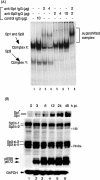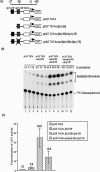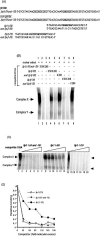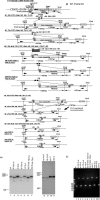Two Sp1/Sp3 binding sites in the major immediate-early proximal enhancer of human cytomegalovirus have a significant role in viral replication
- PMID: 16014922
- PMCID: PMC1181558
- DOI: 10.1128/JVI.79.15.9597-9607.2005
Two Sp1/Sp3 binding sites in the major immediate-early proximal enhancer of human cytomegalovirus have a significant role in viral replication
Abstract
We previously demonstrated that the major immediate early (MIE) proximal enhancer containing one GC box and the TATA box containing promoter are minimal elements required for transcription and viral replication in human fibroblast cells (H. Isomura, T. Tsurumi, M. F. Stinski, J. Virol. 78:12788-12799, 2004). After infection, the level of Sp1 increased while Sp3 remained constant. Here we report that either Sp1 or Sp3 transcription factors bind to the GC boxes located at approximately positions -55 and -75 relative to the transcription start site (+1). Both the Sp1 and Sp3 binding sites have a positive and synergistic effect on the human cytomegalovirus (HCMV) major immediate-early (MIE) promoter. There was little to no change in MIE transcription or viral replication for recombinant viruses with one or the other Sp1 or Sp3 binding site mutated. In contrast, mutation of both the Sp1 and Sp3 binding sites caused inefficient MIE transcription and viral replication. These data indicate that the Sp1 and Sp3 binding sites have a significant role in HCMV replication in human fibroblast cells.
Figures







Similar articles
-
The CREB site in the proximal enhancer is critical for cooperative interaction with the other transcription factor binding sites to enhance transcription of the major intermediate-early genes in human cytomegalovirus-infected cells.J Virol. 2009 Sep;83(17):8893-904. doi: 10.1128/JVI.02239-08. Epub 2009 Jun 24. J Virol. 2009. PMID: 19553322 Free PMC article.
-
Role of the proximal enhancer of the major immediate-early promoter in human cytomegalovirus replication.J Virol. 2004 Dec;78(23):12788-99. doi: 10.1128/JVI.78.23.12788-12799.2004. J Virol. 2004. PMID: 15542631 Free PMC article.
-
Inhibition of human cytomegalovirus replication by overexpression of CREB1.Antiviral Res. 2014 Feb;102:11-22. doi: 10.1016/j.antiviral.2013.11.012. Epub 2013 Dec 5. Antiviral Res. 2014. PMID: 24316029
-
Transactivation of the progesterone receptor gene in granulosa cells: evidence that Sp1/Sp3 binding sites in the proximal promoter play a key role in luteinizing hormone inducibility.Mol Endocrinol. 2003 Mar;17(3):436-49. doi: 10.1210/me.2002-0252. Epub 2002 Dec 12. Mol Endocrinol. 2003. PMID: 12554796
-
Gene regulation by Sp1 and Sp3.Biochem Cell Biol. 2004 Aug;82(4):460-71. doi: 10.1139/o04-045. Biochem Cell Biol. 2004. PMID: 15284899 Review.
Cited by
-
A temporal gate for viral enhancers to co-opt Toll-like-receptor transcriptional activation pathways upon acute infection.PLoS Pathog. 2015 Apr 9;11(4):e1004737. doi: 10.1371/journal.ppat.1004737. eCollection 2015 Apr. PLoS Pathog. 2015. PMID: 25856589 Free PMC article.
-
Human cytomegalovirus inhibition by cardiac glycosides: evidence for involvement of the HERG gene.Antimicrob Agents Chemother. 2012 Sep;56(9):4891-9. doi: 10.1128/AAC.00898-12. Epub 2012 Jul 9. Antimicrob Agents Chemother. 2012. PMID: 22777050 Free PMC article.
-
Inhibition of cellular DNA synthesis by the human cytomegalovirus IE86 protein is necessary for efficient virus replication.J Virol. 2006 Apr;80(8):3872-83. doi: 10.1128/JVI.80.8.3872-3883.2006. J Virol. 2006. PMID: 16571804 Free PMC article.
-
Noncanonical TATA sequence in the UL44 late promoter of human cytomegalovirus is required for the accumulation of late viral transcripts.J Virol. 2008 Feb;82(4):1638-46. doi: 10.1128/JVI.01917-07. Epub 2007 Dec 5. J Virol. 2008. PMID: 18057245 Free PMC article.
-
pUdOs: Concise Plasmids for Bacterial and Mammalian Cells.ACS Synth Biol. 2024 Feb 16;13(2):485-497. doi: 10.1021/acssynbio.3c00408. Epub 2024 Jan 18. ACS Synth Biol. 2024. PMID: 38235654 Free PMC article.
References
-
- Aoyama, T., T. Okamoto, S. Nagayama, K. Nishijo, T. Ishibe, K. Yasura, T. Nakayama, T. Nakamura, and J. Toguchida. 2004. Methylation in the core-promoter region of the chondromodulin-I gene determines the cell-specific expression by regulating the binding of transcriptional activator Sp3. J. Biol. Chem. 279:28789-28797. - PubMed
-
- Apt, D., R. M. Watts, G. Suske, and H. U. Bernard. 1996. High Sp1/Sp3 ratios in epithelial cells during epithelial differentiation and cellular transformation correlate with the activation of the HPV-16 promoter. Virology 224:281-291. - PubMed
-
- Boekhoudt, G. H., Z. Guo, G. W. Beresford, and J. M. Boss. 2003. Communication between NF-κB and Sp1 controls histone acetylation within the proximal promoter of the monocyte chemoattractant protein 1 gene. J. Immunol. 170:4139-4147. - PubMed
Publication types
MeSH terms
Substances
Grants and funding
LinkOut - more resources
Full Text Sources
Other Literature Sources
Miscellaneous

